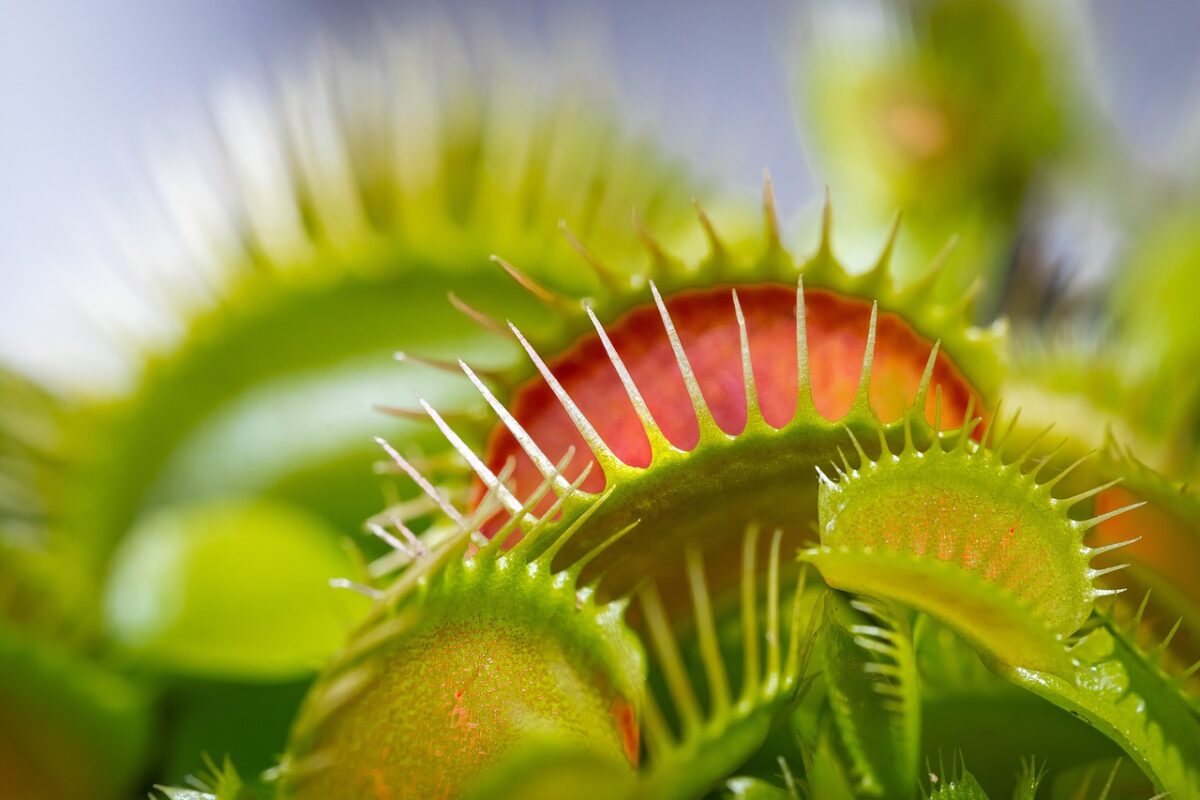Venus Fly Trap Spiritual Meaning: The Carnivorous Plant That Captures Our Imagination
The Venus flytrap is a fascinating carnivorous plant that has captured people’s imaginations for centuries. With its unique trapping mechanism that allows it to capture and digest insect prey, the Venus flytrap seems almost predatory and animal-like among the plant kingdom. As a result, the Venus flytrap has taken on a variety of symbolic and spiritual meanings.
An Introduction to the Venus Flytrap
The Venus flytrap (Dionaea muscipula) is a small carnivorous plant native to the bogs and swamps of North and South Carolina in the United States. A Venus flytrap is made up of a rosette of leaves that have evolved into snap traps to capture insects and other small prey.
The traps are triggered when an insect brushes two or more sensitive hairs inside the trap. This causes the trap to snap shut in a fraction of a second, sealing the prey inside. The trap then slowly digests the prey item, deriving valuable nitrogen and nutrients from the body that would otherwise be lacking in the nutrient-poor soil where the plant grows.
With its ingenious trapping mechanism and unusual diet, the Venus flytrap is truly one of the wonders of the plant kingdom. It continues to capture our imaginations today just as it did when it was first discovered centuries ago.
Symbolic and Spiritual Meanings
So what is it about the Venus flytrap that gives it such profound symbolic meaning? Here are some of the key traits of this carnivorous plant that contribute to its potent symbolism.
A Predator Among Prey
The Venus flytrap’s ability to turn the tables and become the predator rather than passive prey gives it an aura of power and danger. As a sedentary plant rooted in place, most vegetation must passively accept whatever comes their way. But the Venus flytrap is able to take an active, controlling role by luring in and trapping prey.
This ability to flip roles from the hunted to the hunter imbues the Venus flytrap with symbolic meanings of power, autonomy, control, and domination. It becomes a symbol for taking fate into one’s own hands rather than accepting what the world does to you.
The Trap as a Metaphor
The Venus flytrap’s distinctive trapping mechanism is one of its most metaphorically rich features. The idea of luring victims in under false pretenses before entrapping them speaks to ideas of deception, betrayal, and even evil. The snapping trap also symbolizes ideas like inescapable fate, the consequences of temptation, or the suddenness of death.
Comparisons can be made to a seductress, a femme fatale, or the mythical Greek Sirens whose sweet songs would lure sailors to wreck their ships on rocky coastlines. The trap serves as a cautionary metaphor about the dangers of blindly following temptation or beauty.
Digesting Prey
Unlike some other carnivorous plants that simply trap insects until they die, the Venus flytrap goes one step further by actually digesting and deriving nutrients from prey items. This grants additional symbolic meanings related to ideas like the consumption of others for personal gain, ruthlessness and amorality, or even gluttony and greed.
The more sinister connotations depict the Venus flytrap as a sort of “devouring mother” that sadistically toys with victims before slowly dissolving them alive. Here the flytrap can symbolize smothering, possessive, or overly maternal influences that drain away independence and identity.
Rebirth and Renewal
Despite its predatory qualities, the Venus flytrap can also represent ideas of renewal, medicine, and healing. By extracting nutrients from insect prey, the Venus flytrap is able to thrive in environments that would otherwise be too lacking in essential minerals. The plant’s ingenious adaptation for survival speaks to the power of necessity, intellect, and resilience.
The Venus flytrap has a vibrant red color shared by many plants symbolizing vitality or lifeblood. And its periodic consumption of insects could be seen as a sort of renewal or rebirth cycle. Some compare this to spiritual practices like meditation or prayer that let someone periodically withdraw, consume spiritual nourishment, and ultimately attain renewal.
A Touch of Magic
With its exotic look and improbable trapping abilities, it’s little wonder that legends, myths and magic have attached themselves to the Venus flytrap over the years. One legend claims that witches used extracts from these plants as ingredients in their potions and elixirs. The plant’s common name references Venus, the Roman goddess of beauty, perhaps alluding to fictional magical beautifying properties.
The very look of the plant channels popular imaginary depictions of magical flora, as if it would fit right in to a fantasy landscape or magical greenhouse. These associations with magic, legends, and the supernatural further add intrigue and mystique to the Venus flytrap as a carnivorous oddity unlike any other plant.
Positive Symbolic Meanings
The Venus flytrap projects many warnings through its symbolism—temptation, seduction, betrayal, consumption, and more. But it also carries more positive meanings related to ideas of resilience, renewal, power, and even magic.
In a spiritual sense, the Venus flytrap can represent fighting adversity, seeking empowerment, controlling one’s own destiny, and deriving good from harm. Its dramatic trapping motions suggest decisive action, while its vibrant color symbolizes lively energy and confidence.
The Venus flytrap’s unique adaptation to thrive by preying on insects mirrors spiritual practices of extracting positivity from adversity or proactively bettering one’s situation. In an optimistic light, the Venus flytrap uses its traps not for betrayal or temptation, but simply as a survival mechanism without moral implications.
Just as the Venus flytrap can derive vital nutrients from tiny insects that would otherwise be seen as pests, we may be able to transform adversities in our own lives into sources of nourishment, empowerment, or growth.
The Venus Flytrap in Culture and Art
The distinctive look and behavior of the Venus flytrap has made it a frequent subject of artistic depiction and cultural reference. Here are some of the more prominent examples.
Surrealist Art
The surrealist art movement, pioneered by Salvador Dali and others, made use of dream-like symbolism often drawn from the natural world. Carnivorous plants like the Venus flytrap perfectly embodied the surrealists’ interest in the unconscious mind and the animalistic instincts lurking within human nature.
René Magritte’s painting The Companions of Fear depicts a Venus flytrap as a sort of conscious being accompanying two sinister figures. The implication is that the predatory flytrap reflects base desires and morally questionable motivations that drive human behavior.
Songs and Music
The indie rock band TV on the Radio has a song called “Venus Fly Trap” that plays on symbolism of the plant to represent a tempestuous romantic relationship. The lyrics describe being alternately trapped and trapped by the subject, not unlike prey caught in the jaws of the carnivorous plant.
Other musicians like Marina and the Diamonds and Thundercat have also used the Venus flytrap as a metaphor in song lyrics, equating the trapping mechanism with ideas like losing oneself in passion or getting caught up in vice. The plant makes an ideal poetic symbol for dangerous attraction and inescapable entanglement.
Films
Audrey II, the giant alien plant from Little Shop of Horrors, was inspired by the Venus flytrap in both appearance and behavior. Like the flytrap, Audrey II ensnares victims, consumes them, and gains strength from the act. This plays on ideas of temptation, consumption, and the predatory facet of nature.
Carnivorous plants have made appearances in many other horror and sci-fi films from The Ruins to Jumanji: Welcome to the Jungle. They tap into ideas of grotesque death, the monstrous side of nature, and malignant supernatural forces. The familiar Venus flytrap serves as the template for each of these unsettling depictions.
Conclusion
The Venus flytrap holds such symbolic intrigue because it defies simple categorization as either predator or prey, animal or plant. It operates in a grey area between supposed opposites, embracing traits like alluring beauty and underlying danger. This blend of light and dark facets is what infuses the Venus flytrap with such rich spiritual symbolism open to interpretation.
In the right light, the flytrap’s predatory adaptations represent cunning, power, renewal and survival. But the same characteristics suggest ideas of temptation, betrayal and unchecked consumption when taken to extremes. This blend of conflicting meanings reflects the full spectrum of the human experience.
So does the Venus flytrap ultimately symbolize good or evil? As a carnivorous plant it is simply feeding itself, devoid of any moral implications. But through the lens of human nature, its trapping leaves can take on more nuanced meanings related to the light and dark sides within everyone. The Venus flytrap mirrors the full range of human motivations and actions, making it a complex symbol for both admirable and questionable facets of mortal nature.







